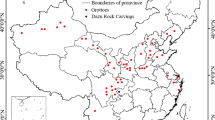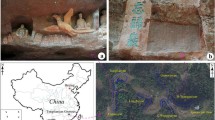Abstract
Salt weathering recognized as an important reason for the weathering of cultural relics. To research the salt weathering of the Banyueshan Giant Buddha in Ziyang, Sichuan, China, the sandstones of the Banyueshan Giant Buddha were taken samples. Through field investigation and laboratory test, the weathering damage types and weathering mechanism of sandstones were defined and analyzed. The research showed that the main weathering damage types of sandstones include exfoliation, soiling, chapping, hollowing and encrustation. The lithotype of the sandstones is confirmed to be yellowish-gray medium-fine grained lithic feldspar sandstone by microscopy. Conventional XRD analysis showed that the clay minerals content and calcite increased in weathered sandstone samples compared with core samples. The results all showed that the soluble salts content of weathered sandstone samples is higher than that of core samples by XRF, XRD of sedimentation separation and soluble salt ion detection. The possibility of damage for soluble salts in sandstone is discussed by considering the local climate conditions, the conversion conditions of various soluble salts and the accompanying crystallization pressure. Finally, it is found that the crystallization expansion of soluble salts under temperature change and dry–wet cycles is the internal reason of promoting weathering. The research results have a good referential value for the protection of culture relics in similar geological environments.









Similar content being viewed by others
Data availability
All relevant data are within the paper.
References
Aly N, Gomez-Hera M, Hamed A, Álvarez De Buergo M, Soliman F (2015) The influence of temperature in a capillary imbibition salt weathering simulation test on Mokattam limestone. Materiales De Construcción (madrid) 65(317):e10–e44. https://doi.org/10.3989/mc.2015.00514
André MF, Phalip B, Voldoire O, Vautier F, Géraud Y, Benbakkar M, Constantin C, Huber F, Morvan G (2011) Weathering of sandstone lotus petals at the Angkor site: a 1,000-year stone durability trial. Environ Earth Sci 63(7–8):1723–1739. https://doi.org/10.1007/s12665-010-0734-9
Benavente D, Cueto N, Martinez-Martinez J, Garcia del Cura MA, Canaveras JC (2007) The influence of petrophysical properties on the salt weathering of porous building rocks. Environl Geol 52(2):197–206. https://doi.org/10.1007/s00254-006-0475-y
Bharmoria P, Gehlot PS, Gupta H, Kumar A (2014) Temperature-dependent solubility transition of Na2SO4 in water and the effect of NaCl therein: solution structures and salt water dynamics. J Phys Chem 118(44):12734–12742. https://doi.org/10.1021/jp507949h
Cañaveras JC, Sanz-Rubio E, Sánchez-Moral S (2022) Weathering processes on sandstone painting and carving surfaces at prehistoric rock sites in southern Spain. Appl Sci 12(11):5330. https://doi.org/10.3390/app12115330
Cao YP, Sun Q, Yang XY, Dang C, Geng JS (2022) Sandstone weathering under dry–wet cycling in NaCl solution. B Eng Geol Environ 81(11):490. https://doi.org/10.1007/s10064-022-02992-6
Cárdenes V, Mateos FJ, Fernández-Lorenzo S (2014) Analysis of the correlations between freeze–thaw and salt crystallization tests. Environ Earth Sci 71(3):1123–1134. https://doi.org/10.1007/s12665-013-2516-7
El-Gohary M, Redwan M (2018) Alteration parameters affecting the Luxor Avenue of the Sphinxes-Egypt. Sci Total Environ 626:710–719. https://doi.org/10.1016/j.scitotenv.2017.12.297
Espinosa-Marzal RM, Scherer GW (2010) Advances in understanding damage by salt crystallization. Acc Chem Res 43(6):897–905. https://doi.org/10.1021/ar9002224
Germinario L, Oguchi CT (2022) Gypsum, mirabilite, and thenardite efflorescences of tuff stone in the underground environment. Environ Earth Sci 81(8):242. https://doi.org/10.1007/s12665-022-10344-6
Ghobadi MH, Babazadeh R (2015) Experimental studies on the effects of cyclic freezing–thawing, salt crystallization, and thermal shock on the physical and mechanical characteristics of selected sandstones. Rock Mech Rock Eng 48(3):1001–1016. https://doi.org/10.1007/s00603-014-0609-6
Hosono T, Uchida E, Suda C, Ueno A, Nakagawa T (2006) Salt weathering of sandstone at the Angkor monuments, Cambodia: identification of the origins of salts using sulfur and strontium isotopes. J Archaeol Sci 33(11):1541–1551. https://doi.org/10.1016/j.jas.2006.01.018
Jimenez-Gonzalez I, Rodriguez-Navarro C, Scherer GW (2008) Role of clay minerals in the physico-mechanical deterioration of sandstone. J Geophys Res 113(F2):F2021. https://doi.org/10.1029/2007JF000845
Kuchitsu N, Ishizaki T, Nishiura T (1999) Salt weathering of the brick monuments in Ayutthaya, Thailand. Eng Geol 55(1–2):91–99. https://doi.org/10.1016/S0013-7952(99)00109-X
Lei YH, Bai L, Zhao F (2022) Archaeological report of the Banyueshan Giant Buddha in Ziyang, Sichuan Province. J Natl Mus China 3:6–19 (in Chinese)
Li HS (2011) Character and Evaluation method of historical rock. Doctoral dissertation, China University of Geosciences (Beijing) (in Chinese)
Li HS, Wang WF, Zhan HT, Qiu F, Guo QL, Sun SL, Zhang GB (2017) The effects of atmospheric moist on the mural paintings of the Mogao Grottoes. Stud Conserv 62(4):229–239. https://doi.org/10.1080/00393630.2016.1148916
Martha RB, del María CAU, Johanna RB, Michel VV, Edison CC (2022) The quantification of physico-mechanical properties and durability of onyx-travertines from Santa Ana de los Ríos de Cuenca, Ecuador. Herit Sci 10(1):194. https://doi.org/10.1186/s40494-022-00826-y
Menéndez B (2017) Estimation of salt mixture damage on built cultural heritage from environmental conditions using ECOS-RUNSALT model. J Cult Herit 24:22–30. https://doi.org/10.1016/j.culher.2016.11.006
Menéndez B, Petranova V (2016) Effect of mixed vs single brine composition on salt weathering in porous carbonate building stones for different environmental conditions. Eng Geol 210:124–139. https://doi.org/10.1016/j.enggeo.2016.06.011
Momeni A, Khanlari GR, Heidari M, Bagheri R, Bazvand E (2015) Assessment of physical weathering effects on granitic ancient monuments, Hamedan. Iran Environ Earth Sci 74(6):5181–5190. https://doi.org/10.1007/s12665-015-4536-y
Oguchi CT, Yu S (2021) A review of theoretical salt weathering studies for stone heritage. Prog Earth Planet Sci. https://doi.org/10.1186/s40645-021-00414-x
Ren KF, Xie ZB, Wang L, Jiang PD, Zhao FF, Chen S, Sun FY (2023) Salt weathering mechanism and climate response in Niujiaozhai Grottoes, Renshou, Sichuan. Geol Rev 69(4):1368–1386. https://doi.org/10.16509/j.georeview.2023.02.065(inChinese)
Rodriguez-Navarro C, Doehne E (1999) Salt weathering: influence of evaporation rate, supersaturation and crystallization pattern. Earth Surf Proc Land 24(3):191–209. https://doi.org/10.1002/(SICI)1096-9837(199903)24:33.0.CO;2-G
Rodriguez-Navarro C, Doehne E, Sebastian E (2000) How does sodium sulfate crystallize? Implications for the decay and testing of building materials. Cem Concr Res 30(10):1527–1534. https://doi.org/10.1016/S0008-8846(00)00381-1
Ruiz-Agudo E, Lubelli B, Sawdy A, van Hees R, Price C, Rodriguez-Navarro C (2011) An integrated methodology for salt damage assessment and remediation: the case of San Jero´nimo Monastery (Granada, Spain). Environ Earth Sci 63(7–8):1475–1486. https://doi.org/10.1007/s12665-010-0661-9
Sato M, Hattanji T (2018) A laboratory experiment on salt weathering by humidity change: salt damage induced by deliquescence and hydration. Prog Earth Planet Sci 5(1):1–10. https://doi.org/10.1186/s40645-018-0241-2
Simona S, Laura G (2020) An experimental investigation into the salt-weathering susceptibility of building limestones. Rock Mech Rock Eng 53(12):5329–5343. https://doi.org/10.1007/s00603-020-02208-x
Sousa L, Siegesmund S, Wedekind W (2018) Salt weathering in granitoids: an overview on the controlling factors. Environ Earth Sci 77(13):502. https://doi.org/10.1007/s12665-018-7669-y
Steiger M, Asmussen S (2008) Crystallization of sodium sulfate phases in porous materials: the phase diagram Na2SO4 –H2O and the generation of stress. Geochim Cosmochim Acta 72(17):4291–4306. https://doi.org/10.1016/j.gca.2008.05.053
Wang YH, Viles H, Desarnaud J, Yang SL, Guo QL (2020) Laboratory simulation of salt weathering under moderate ageing conditions: Implications for the deterioration of sandstone heritage in temperate climates. Earth Surf Proc Land 46(5):1055–1066. https://doi.org/10.1002/esp.5086
Waragai T, Hiki Y (2019) Influence of microclimate on the directional dependence of sandstone pillar weathering in Angkor Wat temple, Cambodia. Prog Earth Planet Sc 6:10. https://doi.org/10.1186/s40645-019-0254-5
Yang H, Chen C, Ni J, Karekal S (2023) A hyperspectral evaluation approach for quantifying salt-induced weathering of sandstone. Sci Total Environ 885:163886. https://doi.org/10.1016/j.scitotenv.2023.163886
Zhang GX, Gong CJ, Gu JG, Katayama Y, Someya T, Gu JD (2019) Biochemical reactions and mechanisms involved in the biodeterioration of stone world cultural heritage under the tropical climate conditions. Int Biodeter Biodegr 143:104723. https://doi.org/10.1016/j.ibiod.2019.104723
Zhao F, Sun Q, Zhang WQ (2020) Combined effects of salts and wetting–drying cycles on granite weathering. B Eng Geol Environ 79(7):3707–3720. https://doi.org/10.1007/s10064-020-01773-3
Zondag H, van Essen M, He Z, Schuitema R, van Helden W (2007) Characterisation of MgSO4 for thermochemical storage. In: Paper presented at the Second International Renewable Energy Storage Conference (IRES II), Bonn, Germany, November 2007
Funding
This work was funded by National Natural Science Foundation of China to Han Fang with Grant number 52274243 and to Shuyun Zhu with Grant number 52274243 and by Science and Technology Department of Sichuan Province to Kefa Ren with Grant number 2020YFS0391.
Author information
Authors and Affiliations
Contributions
H.F wrote the main manuscript text. KF.R prepared tables 1-5,7-8 and figures 4,5, H.F prepared figures 1,2,3,6,7,8,9 and table 6 SY.Z reviewed and revised the article. All authors reviewed the manuscript.
Corresponding author
Ethics declarations
Competing interests
The authors have not disclosed any competing interests.
Additional information
Publisher's Note
Springer Nature remains neutral with regard to jurisdictional claims in published maps and institutional affiliations.
Rights and permissions
Springer Nature or its licensor (e.g. a society or other partner) holds exclusive rights to this article under a publishing agreement with the author(s) or other rightsholder(s); author self-archiving of the accepted manuscript version of this article is solely governed by the terms of such publishing agreement and applicable law.
About this article
Cite this article
Fang, H., Zhu, S. & Ren, K. Study on the salt weathering and mechanism of the Banyueshan Giant Buddha in Ziyang City, Sichuan Province, China. Environ Earth Sci 82, 596 (2023). https://doi.org/10.1007/s12665-023-11294-3
Received:
Accepted:
Published:
DOI: https://doi.org/10.1007/s12665-023-11294-3




